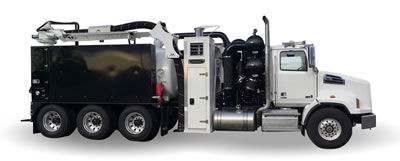What Is The Ground Clearance Of A 16 Foot Penske Moving Truck?
What Is The Ground Clearance Of A 16 Foot Penske Moving Truck? cars.truckstrend.com
Moving can be a complex endeavor, and while most people focus on packing and loading, understanding the dimensions of your rental truck is equally crucial. Among these, ground clearance often goes overlooked, yet it plays a significant role in the safety and success of your move, especially when navigating unfamiliar terrains, driveways, and city streets. For those renting a 16-foot Penske moving truck, knowing its ground clearance isn’t just a technical detail; it’s a practical necessity that can prevent costly damage, ensure a smoother ride, and help you approach your move with confidence.
Ground clearance refers to the minimum distance between the lowest point of a vehicle’s chassis (excluding the tires) and the ground. In a moving truck, this measurement dictates how easily you can clear obstacles like speed bumps, curbs, steep driveways, and even uneven terrain without scraping the undercarriage, damaging components, or getting stuck. For a 16-foot Penske truck, designed for residential and light commercial moves, understanding this dimension is key to maneuvering safely from your old home to your new one.
What Is The Ground Clearance Of A 16 Foot Penske Moving Truck?
Understanding Ground Clearance for a 16-Foot Penske Truck
The 16-foot Penske moving truck is a popular choice for apartment or small home moves, often built on a robust commercial cutaway chassis, typically from manufacturers like Ford (e.g., Ford E-350 or E-450 chassis). Unlike passenger cars, these trucks are designed to carry heavy loads, which directly impacts their ground clearance.
While Penske, like most rental companies, doesn’t publish a single, definitive "ground clearance" figure for all its truck models, we can estimate based on the typical design of commercial vehicles of this size. The lowest point on a 16-foot Penske truck is generally around the rear axle housing (differential) or potentially the rear frame rails, especially when the truck is loaded.
The typical ground clearance for an unloaded 16-foot Penske truck is generally in the range of 8 to 10 inches at its lowest points. However, it’s critical to understand that this figure is dynamic and changes significantly once the truck is loaded with your belongings.
Key Measurement Points to Consider:
- Front Ground Clearance: Usually higher, around 10-12 inches, primarily determined by the front suspension and engine components. Less prone to scraping unless hitting a very large obstacle.
- Mid-Body Ground Clearance: The clearance under the main frame rails and fuel tank, typically consistent with the front when unloaded.
- Rear Ground Clearance: This is often the most critical and lowest point. The rear differential, rear axle, and the bottom of the cargo box/ramp area are the most vulnerable spots. When loaded, the rear suspension compresses, significantly reducing this clearance. The rear "overhang" (the distance from the rear axle to the very end of the truck) can also be a scraping risk on steep transitions.

Factors Influencing Ground Clearance
The static ground clearance provided by the manufacturer is merely a starting point. Several factors come into play that can alter the effective ground clearance of your 16-foot Penske truck during your move:
- Load Weight and Distribution: This is by far the most significant factor. As you load your belongings into the truck, the weight compresses the suspension, particularly the rear leaf springs. A heavily loaded truck will "squat," reducing the rear ground clearance by several inches. Uneven weight distribution (e.g., too much weight at the very back) can exacerbate this issue.
- Suspension System: Commercial trucks like the Penske 16-footer use heavy-duty leaf spring suspensions designed to support substantial loads. While robust, they still deflect under weight. The condition of the springs and shocks can also subtly affect the ride height.
- Tire Size and Pressure: While generally fixed for a rental, the tires contribute to the overall height. Properly inflated tires maintain the designed ride height. Underinflated tires can slightly reduce clearance and negatively impact handling.
- Terrain and Incline: The actual ground clearance is effectively reduced when driving over uneven terrain, through dips, or up steep inclines/declines. A sudden change in elevation, like entering a steep driveway, can cause the front or rear of the truck to bottom out.


Why Ground Clearance is Crucial for Your Move
Understanding and respecting the ground clearance of your 16-foot Penske truck is vital for several reasons:
- Preventing Undercarriage Damage: Scraping the bottom can lead to expensive repairs for fuel lines, exhaust systems, transmission pans, or the frame itself. Even minor scrapes can weaken components over time.
- Navigating Ramps and Driveways: Steep driveways, speed bumps, parking lot entrances, and loading ramps can become significant obstacles. A truck with insufficient clearance can get stuck or scrape severely.
- Loading and Unloading Efficiency: The deck height of the truck (the height of the cargo floor from the ground) is related to ground clearance. While the ramp is designed to bridge this gap, extreme ground clearance issues can affect the ramp’s angle or usability.
- Safety and Stability: Maintaining proper clearance helps ensure the truck’s stability, especially when turning or driving over uneven surfaces. It prevents unexpected jolts that could shift your cargo.
- Avoiding Delays and Frustration: Getting stuck or damaging the truck can cause significant delays to your moving schedule and add unnecessary stress.
Practical Tips for Driving a 16-Foot Penske with its Ground Clearance in Mind
Maneuvering a large vehicle like a 16-foot Penske truck requires a different approach than driving a passenger car. Keeping ground clearance in mind will make your move smoother and safer:
- Approach Obstacles Diagonally: When encountering speed bumps, steep driveways, or significant dips, try to approach them at an angle (diagonally) rather than straight on. This allows one wheel to go over the obstacle at a time, effectively increasing the clearance by keeping two wheels on higher ground, reducing the chance of the center or rear bottoming out.
- Assess Before You Proceed: Before driving up a steep driveway, into an unfamiliar parking lot, or over a large speed bump, stop and visually assess the situation. If possible, get out and walk the path to identify potential scraping points.
- Mind the Rear Overhang: The 16-foot Penske truck has a significant rear overhang. When backing up, or turning sharply on an incline, be acutely aware of the tail end. It’s prone to scraping on curbs or elevated surfaces.
- Load Smartly: Distribute your cargo as evenly as possible throughout the truck’s cargo area. Avoid concentrating all the heaviest items at the very rear, as this will cause excessive rear suspension sag and drastically reduce ground clearance. Place heavy items towards the front and center of the cargo box.
- Use a Spotter: Whenever possible, especially when backing up, maneuvering in tight spaces, or entering/exiting challenging driveways, have a friend or family member act as a spotter. They can provide crucial real-time feedback on clearance.
- Be Mindful of Road Conditions: Potholes, construction debris, and uneven road shoulders can all pose a threat to your truck’s undercarriage. Drive cautiously and be prepared to slow down or navigate around such hazards.
- Check Tire Pressure: Before you start your journey, ensure the tires are properly inflated according to the manufacturer’s recommendations (usually found on a sticker inside the driver’s door jamb). Correct tire pressure helps maintain the truck’s designed ride height.
Potential Challenges and Solutions
Even with careful planning, challenges can arise. Here’s how to address common ground clearance issues:
- Scraping the Rear on Steep Inclines/Declines: This is the most common issue.
- Solution: Employ the diagonal approach. If it’s still too steep, consider alternative routes or unloading some items if feasible to lighten the load and raise the rear. Sometimes, carefully backing up an incline can be better than driving forward, as the front has more clearance.
- Getting Stuck on Soft Ground or Uneven Terrain:
- Solution: Penske trucks are not designed for off-road use. Stick to paved surfaces or well-maintained gravel roads. If you find yourself on soft ground, avoid spinning the tires, which can dig you in deeper. Try gently rocking the truck (forward and reverse if safe) to gain traction. Avoid driving onto unpaved areas unless absolutely necessary and assessed as safe.
- Difficulty with Loading Ramps/Docks: If the truck’s deck height (influenced by ground clearance) doesn’t align well with a loading dock or a portable ramp, making the angle too steep.
- Solution: Adjust the truck’s distance from the dock or ramp. Sometimes, moving the truck slightly closer or further away can improve the angle. For portable ramps, ensure they are rated for the truck’s weight and your cargo. If using a fixed dock, ensure it’s compatible with the truck’s height.
Table of Key Specifications for a 16-Foot Penske Moving Truck
While exact ground clearance varies, here’s a general overview of key specifications for a 16-foot Penske truck, including approximate ground clearance figures. Please note these are typical values and can vary slightly based on the specific model year, chassis, and load.
| Specification | Approximate Measurement (Unloaded) | Notes |
|---|---|---|
| Ground Clearance (Lowest Point) | 8 – 10 inches (at rear differential/frame) | Varies significantly with load; typically lowest at the rear axle. |
| Ground Clearance (Front) | 10 – 12 inches | Higher than the rear; less prone to scraping. |
| Interior Box Length | 16 ft. (192 inches) | Usable cargo space. |
| Interior Box Width | 7 ft. 8 in. (92 inches) | |
| Interior Box Height | 6 ft. 6 in. (78 inches) | |
| Deck Height (from ground) | 2 ft. 9 in. (33 inches) | Height of the cargo floor; affects ramp angle. |
| Door Opening (W x H) | 6 ft. 6 in. W x 6 ft. 2 in. H (78 in. x 74 in.) | Clearance for getting items into the truck. |
| Loading Ramp Length | Approx. 10-12 ft. (retractable) | Provides a gradual slope for loading; check specific truck for ramp details. |
| Gross Vehicle Weight Rating (GVWR) | 14,500 lbs (approx.) | Maximum allowed weight of the truck itself + its payload. |
| Payload Capacity | 6,000 – 7,000 lbs (approx.) | Maximum weight of cargo you can safely carry; deduct from GVWR. |
| Fuel Tank Capacity | 33 – 40 gallons (approx.) | Helps plan fuel stops. |
| Exterior Height | Approx. 10 ft. – 10 ft. 6 in. (120-126 inches) | Critical for low bridges, tunnels, drive-thrus, and parking garages. |
| Exterior Width | Approx. 8 ft. (96 inches) (including mirrors) | Important for narrow streets and parking. |
| Turning Radius | Relatively large (requires wide turns) | Be aware of tail swing and wide turning circles. |
Disclaimer: These are approximate values and can vary based on model year, specific vehicle, and load. Always consult the specific truck’s dimensions and weight ratings provided by Penske.
Frequently Asked Questions (FAQ)
Q1: What is the minimum ground clearance of a 16-foot Penske truck?
A1: While not an exact published figure, the lowest point on a 16-foot Penske truck, typically the rear differential or frame when unloaded, is generally around 8 to 10 inches. This figure significantly decreases when the truck is loaded.
Q2: Does loading the truck affect ground clearance?
A2: Absolutely. Loading the truck, especially with heavy items, compresses the suspension, reducing the ground clearance, particularly at the rear. A fully loaded truck can see its rear ground clearance reduced by several inches.
Q3: Can I drive a Penske truck off-road or on very uneven terrain?
A3: No. Penske moving trucks are designed for use on paved roads and well-maintained surfaces. Driving them off-road or on very uneven terrain can easily lead to scraping the undercarriage, damaging components, or getting stuck. Their low ground clearance (especially when loaded) and lack of four-wheel drive make them unsuitable for such conditions.
Q4: How do I avoid scraping the bottom of the truck?
A4: The best strategies include approaching speed bumps and steep driveways diagonally, assessing the terrain before driving over it, being mindful of the rear overhang, and loading the truck evenly to minimize suspension sag. Using a spotter is also highly recommended.
Q5: Is the loading ramp part of the ground clearance calculation?
A5: The loading ramp itself is generally stored within the truck’s body or slides out from underneath, so it’s not typically the lowest point when the truck is in motion. However, the area from which the ramp deploys, at the very rear of the truck, is often a vulnerable spot for scraping, especially on steep transitions.
Q6: What’s the best way to load a Penske to maintain clearance?
A6: Distribute weight as evenly as possible from front to back and side to side. Place the heaviest items low and towards the center or slightly forward of the rear axle. Avoid stacking all heavy items at the very back of the truck, as this will cause the rear to sag excessively, reducing ground clearance.
Conclusion
The ground clearance of a 16-foot Penske moving truck, typically ranging from 8 to 10 inches unloaded at its lowest points, is a critical dimension that significantly impacts your moving experience. While not a figure most people consider initially, understanding its implications for maneuverability, safety, and potential damage is paramount.
By being aware of how factors like load weight affect clearance and by employing smart driving techniques such as diagonal approaches and careful assessment of terrain, you can navigate common obstacles with confidence. Knowing these details empowers you to prevent costly undercarriage damage, avoid getting stuck, and ensure a smoother, more efficient move. So, before you hit the road, take a moment to consider what’s beneath your Penske, and you’ll be well on your way to a successful relocation.




